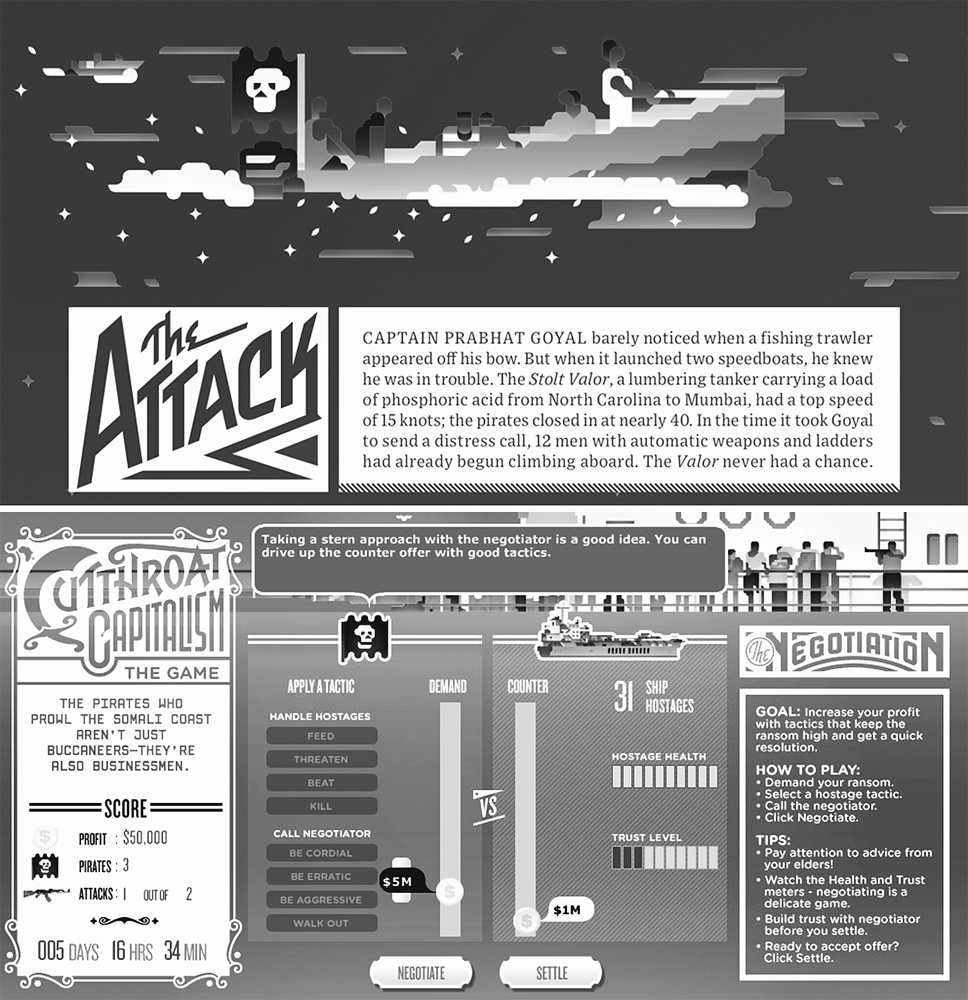Newsgames
Newsgames
Journalism at Play
Ian Bogost, Simon Ferrari, and Bobby Schweizer
The MIT Press
Cambridge, Massachusetts
London, England
2010 Massachusetts Institute of Technology
All rights reserved. No part of this book may be reproduced in any form by any electronic or mechanical means (including photocopying, recording, or information storage and retrieval) without permission in writing from the publisher.
For information about special quantity discounts, please email special_sales@ mitpress.mit.edu
Library of Congress Cataloging-in-Publication Data
Bogost, Ian.
Newsgames : journalism at play / Ian Bogost, Simon Ferrari, and Bobby Schweizer.
p. cm.
Includes bibliographical references and index.
ISBN 978-0-262-01487-8 (hardcover : alk. paper)
ISBN 978-0-262-28908-5 (retail e-book)
1. Video games. 2. Online journalism. 3. Interactive multimedia. I. Ferrari, Simon.
II. Schweizer, Bobby. III. Title.
GV1469.3.B64 2010
794.8 dc22
2010011990
10 9 8 7 6 5 4 3 2 1
Acknowledgments
Research for this book was made possible by a generous grant from the John S. and James L. Knight Foundation. Wed like to extend special thanks to the journalism program staff at the foundation, and particularly to Alberto Ibargen, Eric Newton, Jessica Goldfin, Gary Kebbel, and Jenne Hebert.
Additional gratitude goes to graduate students in the Georgia Tech Digital Media program who participated in this research: Mariam Asad, Ayoka Chenzira, Nick Diakopoulos, Tom Gibes, Sergio Goldenberg, Cinqu Hicks, Tanyoung Kim, Adam Rice, Digdem Sezen, Tongu Sezen, Ray Vichot, and Douglas Wilson. We are indebted to their many thoughtful suggestions, many of which shed light on subjects that would have otherwise escaped notice.
Of these researchers, Goldenberg, Vichot, and Wilson require special credit for contributions that have been incorporated into this book. Where needed, these have been indicated in the notes.
Newsgames
Piracy off the coast of the east African nation of Somalia has run rampant since the start of a civil war in the early 1990s, but attacks have become more frequent and more daring in recent years. By the spring of 2008, pirates were venturing well away from the Somali coast in order to reach the higher-value vessels that enter and exit the Gulf of Aden, gateway to the Red Sea and eventually the Suez Canal and the Mediterranean.
With numerous international governments concerned about the safety and viability of their shipping routes, the United Nations Security Council established Resolution 1838 in October 2008, calling on member nations to deploy naval vessels and military aircraft in support of maritime security in the region.
But Wired magazines writers sailed a different tack in their July 2009 feature on Somali pirates, choosing to focus on economics over politics or personality. It stands to reason, argues Carney, that this escalation had arisen not from the depths of new wickedness and anarchy, but from the changing economic dynamics of piracy itself.
Unlike its more mainstream counterparts in the New York Times or the Guardian, Wireds coverage looks more like a spreadsheet than an investigative report. It features eight full-color pages of text, infographics, and diagrams, all meticulously illustrated and annotated by Siggi Eggertsson and Michael Doret. The graphics are playful, their rounded-edged pixel art abstracting boats, people, and maps into actors in an economic system (figure 1.1). The coverage itself takes a procedural rather than a narrative approach: it is divided into sections that describe the different steps of an attack, each section offering a textual description, an infographic, and a ledger or algorithm describing the economic dynamics of the topic.
The articles infographics run the gamut from mundane to remarkable, from bar graphs and pie charts to fever charts and a full-page map. The piece also deploys unusually complex typography to highlight different economic forces. Taken together, the spreads illustrate how a piratical Chief Financial Officer might witness a highjack-and-ransom attack from the vantage point of a ledger rather than a skiff. Each step calculates and summarizes its value proposition, and in so doing the feature explains the risk-reward system of ransom piracy by showing how the Somali pirates act according to a highly logical, if disruptive, self-interest.
Much about Cutthroat Capitalism reminds the reader of a videogame. Its visual design riffs off the blocky art of early coin-op and home console games, a method commonly used on screen and in print to apply videogame aesthetics to serious topics. But something else makes this decidedly static print feature resemble a game more than a column. Good games depict system dynamics rather than narrating specific accounts. Instead of telling a story about a particular pirate crew or hijacked freighter, the article characterizes the economic system of Somali piracy in general.
Of course, Cutthroat Capitalism isnt a game. Its a set of descriptions, formulas, and tabular data that describes the behavior of a system rather than simulating the system directly. A reader of Wired could get out a pencil and paper to determine a strategy for a hypothetical pirate raid, but it would be much easier to let a computer do the work.
Wired realized as much, so they paired Cutthroat Capitalism, the article, with a Web-based game of the same name, one that operates under the same mathematical logic the article describes. The game puts the reader at the helm: You are a pirate commander staked with $50,000 from local tribal leaders and other investors. Your job is to guide your pirate crew through raids in and around the Gulf of Aden, attack and capture a ship, and successfully negotiate a ransom. The result effectively simulates capture and negotiation, synthesizing the principles of the print spread into an experience rather than a description.

Figure 1.1
The similarities between Cutthroat Capitalism the magazine spread and Cutthroat Capitalism the game go beyond their visual design. Each describes the economic system of piracy off the coast of Somalia: one with words, the other through play.
The player begins on a map of coastal Somalia. The shiprepresented by a skull tokenstarts in the city of Eyl, a pirate haven north of the capital of Mogadishu. When the player clicks on a part of the map, the pirate ship moves. Once in the Gulf of Aden, players click on passing shipsdepicted as colored dots representing different classesmoving the pirate vessel toward a target. If the players skull token intersects with one of these dotsbe it container ship, cargo ship, cruise ship, tugboat, or one of five other classesthe game presents a chance to capture the ship and proceed with ransom negotiations. If the player fails to intercept, the crew is forced to sail back up the coast to try again.
The negotiation process consists of turns in which the player can choose a behavior to exhibit toward the hostages aboard the ship (feed, threaten, beat, or kill), a stance to take with the negotiating party (be cordial, erratic, aggressive, or walk out), and a ransom demand of up to $30 million. The game rules remind the player that the highest ransom ever paid was only $3 million. A complex calculus of these choices determines the health of the hostages, the mood of the negotiators, and the likelihood of a counteroffer.
Hijacking a ship turns out to be a process just as methodical as buying a car. Negotiation proves effective only when the player quickly divines the value of the ship and its hostages, and then works carefully and methodically toward that monetary goal. If the player successfully negotiates a ransom, the reward (covered by the vessels insurer) is split between the local government, the tribal leaders and investors who staked the journey, and the crew. But if the pirate crew abandons ship or the players forces are overrun, the negotiation ends in failure.









